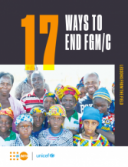Seventeen Ways to End Female Genital Mutilation/Cutting
The 2016 Annual Report for the UNFPA-UNICEF Joint Programme on Female Genital Mutilation/Cutting provides two perspectives: The main document analyses progress in quantitative terms, provides an account of how our budget was allocated and offers profiles of each of the 17 programme countries.
This companion booklet-17 Ways to End FGM/C– uses a qualitative and narrative approach to examine more specifically the challenges, complexities and achievements on the ground. It explores the innovative approaches the Joint Programme teams, partners and activists employ to deconstruct the social norms that allow FGM/C to continue in many communities.
The work of the Joint Programme is complicated because FGM/C is not one practice—it is a tradition that carries different meanings for different communities, and sometimes multiple meanings within one community. FGM/C may be ostensibly practised for reasons of hygiene or aesthetics, or out of a sense of religious, cultural or familial obligation. It may appear to enjoy widespread support, even while privately opposed by a significant proportion of the community. Or it may be carried out surreptitiously by a few. But what makes ending FGM/C so complex is that, in almost all contexts, parents genuinely want to do what is right for their child and family.
